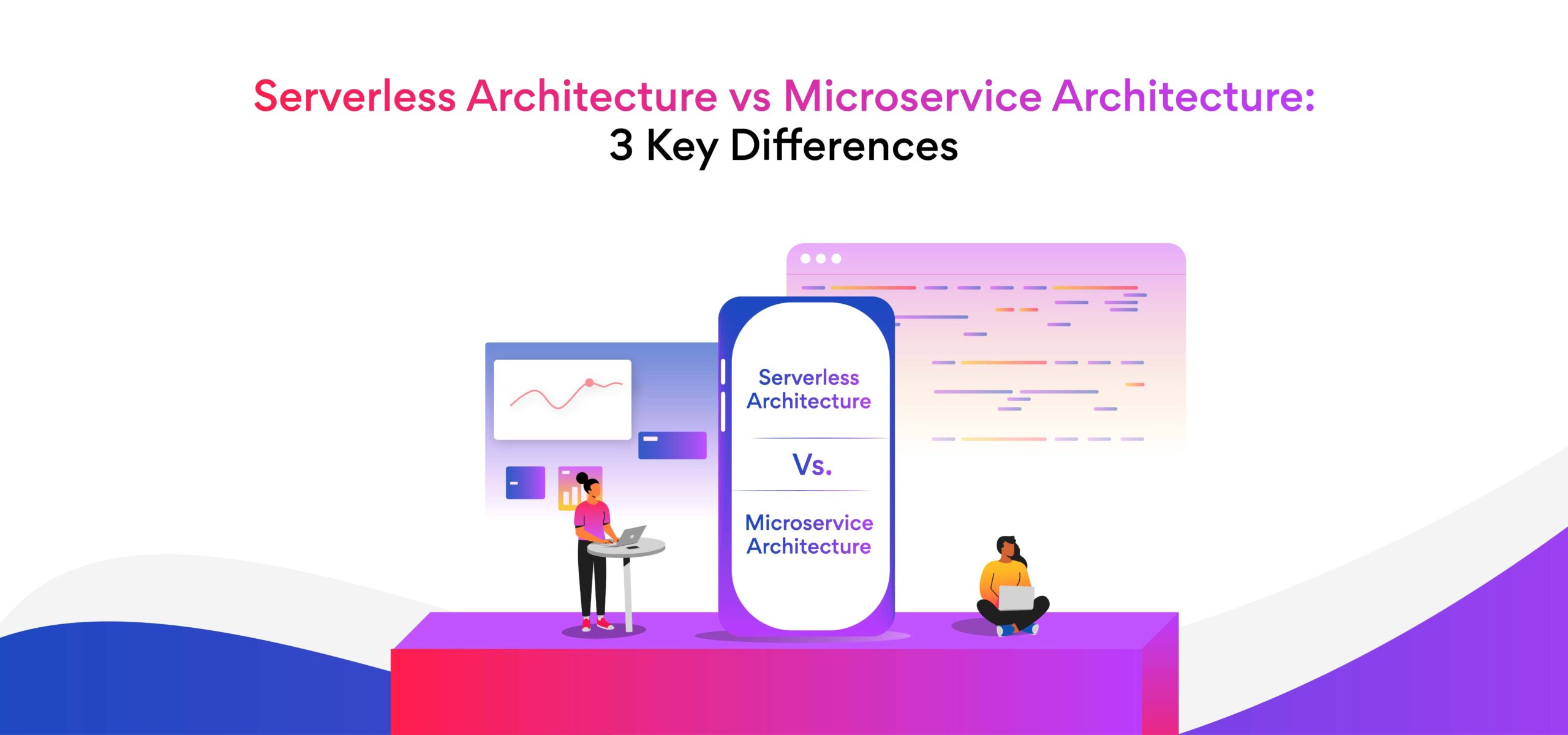What is microservice architecture? What is serverless architecture?
Is serverless good for microservices? Is Lambda a microservice?
What is the difference between microservices and Lambda?
Is a serverless framework better for hosting microservices?
We will answer these questions in this article, keep reading!
What is microservice architecture?
Microservice architecture is an architectural pattern that arranges an application as a collection of loosely-coupled, fine-grained services communicating through lightweight protocols.
Microservices divide an application into a number of autonomous functions, which collaborate and interact with one another via APIs.
Every microservice is independently tested and has its own database, libraries, and templates. Also, it’s frequently contrasted with a monolithic construction.
Every component of microservices is independent of one another, so you don’t need to run a full program to use a single feature.
For example, creating profiles, searching for music, creating playlists, and playing music are all distinct operations in a music streaming service that can be divided into a number of microservices. You only need to develop a new microservice and connect it to the rest of the system if you require a new feature.
How does microservice architecture work?
Microservices are autonomous parts that manage a certain functionality. Each service manages a certain process and operates independently.
Practically, this idea is put into practice using containers. Developers frequently create microservices in containers using templates and code libraries. Each container contains everything a component needs to operate and offers a running environment for the service. The most widely used option for container development is Docker.
The development team goes through the following stages to implement a microservice architecture:
- Decomposition: Divide the app’s features into smaller sections.
- Design: Determine the connections between each service once you know which ones you will be working with. The hierarchy must also be established; which microservices will be dependent upon whom?
- Development: Create services as soon as the team has a map of the microservices and is clear on how the various parts of the system will work together.
- Deployment: Set microservices as FaaS in a serverless environment, distinct VMs, or containers.
What are the benefits of microservice architecture?
- Capacity to build, test, and deploy services separately without negatively affecting other services or the parent application.
- Increased agility through quicker development and problem-solving without depending on the application’s full release.
- Performance can be scaled easily when traffic surges.
- Flexibility to employ a variety of technologies and adjust business logic.
- Can be modified and used again in a variety of procedures or circumstances.
What are the challenges of microservice architecture?
- When an application is divided into independent components, complexity rises.
- Increased effort is required to oversee numerous databases, guarantee data consistency, and watch each microservice.
- APIs for microservices are four times more prone to security breaches.
- For smaller businesses that need to quickly implement and iterate, microservices can be too slow and complex.
- Higher test coverage and more stringent interface constraints are required in a distributed system.
- The higher cost is involved.
What is serverless architecture?
Serverless architecture is a way to build and run web applications and services without managing their infrastructure.
In a serverless architecture, the third-party cloud provider manages the server. The only thing that developers need to worry about is the code. The service provider handles everything, including security fixes, capacity management, scalability, logging, load balancing, and monitoring.
Serverless architecture can execute the complete program or just a portion of it. The server is only used when the application is in use; it allocates resources to the app as soon as its code is executed and releases them when the app is no longer in use. The app owner is charged only for the period when the app is running.
Backend-as-a-Service (BaaS) and function-as-a-service (FaaS) are two options that cloud providers can give. BaaS provides pre-built functionalities, allowing the developer to focus solely on the front end. Due to its limited customization and control, it is rarely used.
Contrarily, FaaS is more adaptable. You can create an application as a collection of functions with FaaS. Each function has a trigger that causes activation. The function can never run continually; it is often temporary and is shut off as soon as it is no longer needed.
How does serverless architecture work?
In a serverless architecture, businesses host their application functions using the resources of outside vendors. The application’s logic and features are separated into functions, which are compact units that carry out discrete tasks in a limited time. As a reaction to a trigger, every function has a recursive activation option.
Building responsive applications that swiftly handle user requests and utilize little RAM is possible with serverless architecture.
Serverless architecture is affordable, quick, and lightweight. Also, serverless architecture is a preferred solution for real-time apps, virtual assistants, MVPs, etc..
To implement a serverless architecture, the development team goes through the following stages:
- Functions: Code is created by programmers to carry out specific tasks for the application. Usually, it’s a quick and easy process.
- Event: Events are assigned by programmers to each function. Later, they enable functions if the predetermined conditions are satisfied. An HTTP request is an example of an event.
- Trigger: The function is triggered when a user pushes a specific key, taps a screen at a specific location, or clicks a button.
- Execution: Runtime for the function begins.
- Output: Users receive updates via a specific output on the client side of the application.
What are the benefits of serverless architecture?
- Increased emphasis on producing high-quality applications for faster deployment.
- Uses fewer resources to create, maintain, and improve the underlying infrastructure.
- Best suited for quick, real-time procedures.
- Less expensive to hire database and server specialists.
- Availability of various subscription-based pricing models for effective budget prediction.
- Rapid scaling without degrading performance.
- The vendor holds responsibility for the management of computing resources.
What are the challenges of serverless architecture?
- Changes in business logic or technology can make switching to a different vendor difficult.
- If/when a neighboring tenant releases complex code, multi-tenant serverless platforms can cause performance difficulties.
- When an application or function is started after being inactive for a long time, it may need a ‘cold start,’ which requires more time and effort.
What are the key differences between microservice architecture and serverless architecture?
Here are a few key considerations while deciding whether to use microservices or serverless architectures.
- Approach
Team resources are necessary for microservices because an internal or external team carries the tasks of monitoring, deployment, support, and maintenance. These teams also support the architecture, handle its computing, and ensure its safety.
Contrarily, serverless architecture depends on a third-party vendor. The business is not required to create, protect, and manage its server space. The cloud provider handles all internal functions. With this strategy, the project costs less. - Cost
Microservices’ creation and upkeep are more expensive because they rely on internal resources and team support. However, there are many benefits to this strategy. For example, the business does not rely on outsiders and does not run the risk of vendor lock-in.
On the other hand, the ability to cut expenses is the primary competitive advantage of serverless architecture. Businesses that employ serverless architecture gain from pooling resources. They receive competitive pricing from vendors and save HR and admin costs. - Runtime
The runtime of serverless functions is constrained. Every provider has a cap on how long a certain function can run. For instance, a function on AWS Lambda can run for 15 minutes. This is because functions are intended to be quick activities that don’t use a lot of RAM.
On the other hand, vendor requirements for runtime, storage space, and RAM do not apply to microservices. They are, therefore, more suited for intricate, long-term activities that need the storage and manipulation of massive volumes of data.
Bottom line
Both serverless systems and microservices have benefits and drawbacks. Therefore, it all boils down to evaluating the business objectives and product scope of your organization before choosing an architecture.
Serverless is a smart option if cost and speed to deploy-to-market are priorities. However, microservices are a more realistic choice if your company plans to create a huge, sophisticated application.
Alternatively, it is also possible to merge both of these technologies into a single cloud-native instance with the correct team and effort.



